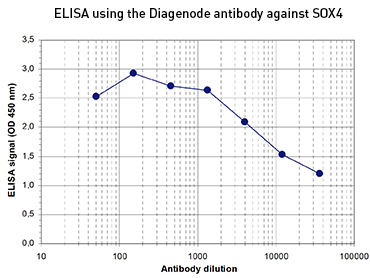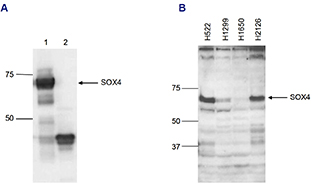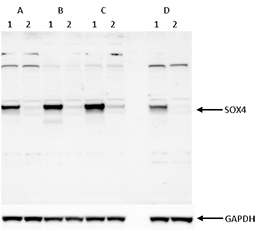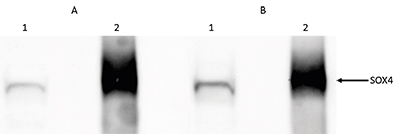How to properly cite our product/service in your work We strongly recommend using this: SOX4 Antibody (Hologic Diagenode Cat# C15310129 Lot# A574-004 ). Click here to copy to clipboard. Using our products or services in your publication? Let us know! |
MiR-129-5p exerts Wnt signaling-dependent tumor-suppressive functionsin hepatocellular carcinoma by directly targeting hepatoma-derived growthfactor HDGF.
Huge Nicole et al.
BACKGROUND: In hepatocellular carcinoma (HCC), histone deacetylases (HDACs) are frequently overexpressed. This results in chromatin compaction and silencing of tumor-relevant genes and microRNAs. Modulation of microRNA expression is a potential treatment option for HCC. Therefore, we aimed to characterize the epigen... |
Differential Expression of Members of SOX Family of Transcription Factorsin Failing Human Hearts
Chia-Feng, Liu and Ying, Ng and Varun, Thachil and Michael, Morley andChristine, S Moravec and W., H. Wilson Tang
Background: The Sry-related high-mobility-group box (SOX) gene family, with 20 known transcription factors in humans, plays essential roles during development and in many disease processes. Several SOX proteins, e.g., SOX4, SOX11, and SOX9, are required for normal heart morphogenesis. SOX9 was shown to contribute to... |
Global analysis of histone modifications and long-range chromatin interactions revealed the differential cistrome changes and novel transcriptional players in human dilated cardiomyopathy.
Liu CF, Abnousi A, Bazeley P, Ni Y, Morley M, Moravec CS, Hu M, Tang WHW
BACKGROUND: Acetylation and methylation of histones alter the chromatin structure and accessibility that affect transcriptional regulators binding to enhancers and promoters. The binding of transcriptional regulators enables the interaction between enhancers and promoters, thus affecting gene expression. However, ou... |
SOX4 can redirect TGF-β-mediated SMAD3-transcriptional output in a context-dependent manner to promote tumorigenesis.
Vervoort SJ, Lourenço AR, Tufegdzic Vidakovic A, Mocholi E, Sandoval JL, Rueda OM, Frederiks C, Pals C, Peeters JGC, Caldas C, Bruna A, Coffer PJ
Expression of the transcription factor SOX4 is often elevated in human cancers, where it generally correlates with tumor-progression and poor-disease outcome. Reduction of SOX4 expression results in both diminished tumor-incidence and metastasis. In breast cancer, TGF-β-mediated induction of SOX4 has been shown... |
SOX4 inhibits oligodendrocyte differentiation of embryonic neural stem cells in vitro by inducing Hes5 expression
Braccioli Luca, Vervoort Stephin J., Puma Gianmarco, Nijboer Cora H., Coffer Paul J.
SOX4 has been shown to promote neuronal differentiation both in the adult and embryonic neural progenitors. Ectopic SOX4 expression has also been shown to inhibit oligodendrocyte differentiation in mice, however the underlying molecular mechanisms remain poorly understood. Here we demonstrate that SOX4 regulates tra... |
TRPM7 controls mesenchymal features of breast cancer cells by tensional regulation of SOX4.
Kuipers AJ, Middelbeek J, Vrenken K, Pérez-González C, Poelmans G, Klarenbeek J, Jalink K, Trepat X, van Leeuwen FN
Mechanically induced signaling pathways are important drivers of tumor progression. However, if and how mechanical signals affect metastasis or therapy response remains poorly understood. We previously found that the channel-kinase TRPM7, a regulator of cellular tension implicated in mechano-sensory processes, is re... |
Cancer cell specific inhibition of Wnt/β-catenin signaling by forced intracellular acidification.
Melnik S, Dvornikov D, Müller-Decker K, Depner S, Stannek P, Meister M, Warth A, Thomas M, Muley T, Risch A, Plass C, Klingmüller U, Niehrs C, Glinka A
Use of the diabetes type II drug Metformin is associated with a moderately lowered risk of cancer incidence in numerous tumor entities. Studying the molecular changes associated with the tumor-suppressive action of Metformin we found that the oncogene , which is upregulated in solid tumors and associated with poor p... |
Sox4 Expression Confers Bladder Cancer Stem Cell Properties and Predicts for Poor Patient Outcome
Shen H et al.
Genetic and epigenetic alterations have been identified as to contribute directly or indirectly to the generation of transitional cell carcinoma of the urinary bladder (TCC-UB). We have previously found that amplification of chromosome 6p22 is significantly associated with the muscle-invasive rather than superficial... |
Novel transcriptional targets of the SRY-HMG box transcription factor SOX4 link its expression to the development of small cell lung cancer.
Castillo SD, Matheu A, Mariani N, Carretero J, Lopez-Rios F, Lovell-Badge R, Sanchez-Cespedes M
The HMG box transcription factor SOX4 involved in neuronal development is amplified and overexpressed in a subset of lung cancers, suggesting that it may be a driver oncogene. In this study, we sought to develop this hypothesis including by defining targets of SOX4 that may mediate its involvement in lung cancer. Ab... |






